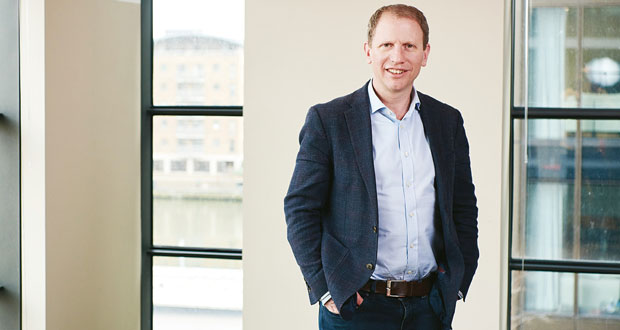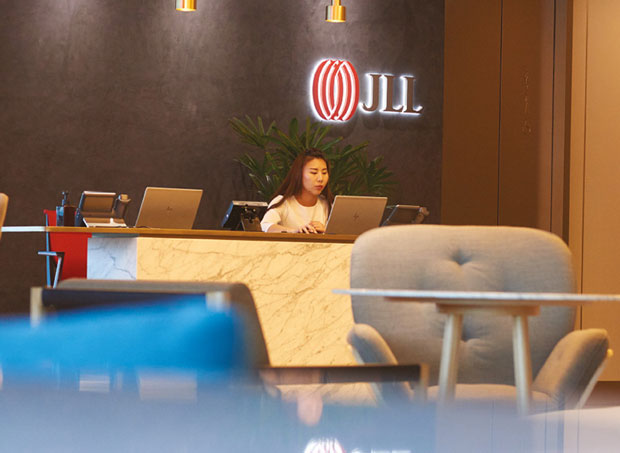DYNAMIC SERVICES IN ACTION
He cites the case study of Xerox to help demonstrate this approach. The print company opened a new London HQ with four different tiers of flexibility in 2020. They took a traditional lease with a showcase fitout and a second floor on a shorter lease that was fitted out on a more ‘vanilla’ basis. They rented a further space by the desk from the landlord and finally, the landlord installed a coworking space in the building so that the few days a year that the site was over-capacity, because for instance the executives had flown in, they’ve got some spillover.
Explains Franklin: “That layering of flexibility enabled the business to breathe over time, and it could expand and contract. For any business in a period of uncertainty, that’s hugely invaluable.”
He is adamant that one of the key principles to the dynamic management approach is not to fractionalise or move to zero hours employment, so the question for FMs is how to buy in services that meet this fluctuating demand?
Forward knowledge of how that demand is going to change is the key he explains, and this doesn’t necessarily mean “jumping to technology”.
“You don’t need technology to tell you that Fridays are quiet days, but that enables you to say ‘I still need a receptionist on a Friday, so why not look to move away from three receptionists every day to a single receptionist on a Friday where the FM covers the lunch break? I then take that capacity, and I repurpose it to those intensive days of working.’ This principle can be done within a week, within a month or within a year.”
This leads to a conversation for the industry around new employment contracts. For instance, where you can design employment contracts that match demand throughout the year. This might vary from stretching the work hours on certain days or even months, with other days off. Employees might be paid more for that flexibility, and many may value it. For FM: “what you’re then able to do is start balancing demand to supply in services.”
BEGINNING THE PROCESS
Following this model, property people can begin by looking at the data they’ve already got, including room and desk bookings to detect usage as well as forecast demand by analysing data on future working patterns and service delivery demand. AI will increasingly play an important part in this, but it’s how this demand is managed which will be critical in its success.
He warns that manning buildings with all full-time staff solely assigned to specific services such as cleaning or security will limit dynamic real estate management, which again is where we can learn from hospitality – where staff have primary roles and deployed where needed to tailor the customer service response.
He explains: “What hotels do most effectively that we can learn from is segment their demand. They look very carefully at the different type of customer and their buying behaviours. You’ve got the leisure traveller who wants the lowest cost point, and you’ve got the executive business traveller who doesn’t care about price, but convenience and luxury service.
“If I bring that back into our world, sales people and executives focused on convenience need to be in the office on Tuesdays, Wednesdays and Thursdays for meetings and collaboration. By comparison, the back-office functions of a business; finance, HR, governance, don’t necessarily need to be in on those days. What we can do then is – just like the hospitality sector – look at availability and ask them to book their team gatherings on a Friday. We can then offer enhanced amenities or lower costs on those days as a reward for coming in on those off-peak days.
“If this is booked well in advance, we can then go to our catering provider and order off-peak day ‘packages’ seeking marginal cost pricing. An extra amenity cost can be very small, and eclipsed if you’ve avoided holding surplus real estate.
“That segmentation approach enables you to start filling the space up every day but filling it in different ways. Mimicking the loyalty aspects of the hotel industry is powerful as well, because it enables companies to reward behaviours at the individual level that minimise corporate real estate costs.”
The key to delivering this type of service, he stresses, is in employing multi-disciplinary staff, emulating hotels for instance where general managers, reservation managers and reception staff can all respond to increased demand such as a queue at the front desk. Within FM that may involve a post room person, supports reception or security staff (if appropriately licensed), or completing a room reset when needed.
The model can also be applied to hard services. Clients may request having an engineer on site, 24/7 ‘just in case’ but if that engineer is at lunch, it could still be 45 minutes before they’re available. If instead engineers are deployed across multiple clients, there could be a choice of engineers to service an incident. The result? Faster resolution rather than faster response deploying an expert rather than a generalist who can support a host of buildings. Tech can also play a role with the use of sensors for offsite monitoring to make sure that plant isn’t going to fail in the first place.
Franklin admits this approach: “Requires facilities management providers to change our ways of thinking in our commercial models and our clients to trust the industry to respond as quickly as they do today but be more efficienct and effective in the process.
“It all comes back to interlinking many concepts. You can liberalise employment, de-risk that by using a smart building solution and run your building more intensely. By doing so you can take less space at less cost and less waste which means less carbon, which is the ultimate win.”
PULLING IT ALL TOGETHER
While Franklin acknowledges adopting the dynamic real estate management model will be driven by Corporate Real Estate, he believes the power in launching it comes from FM. Their knowledge and understanding from being on the ground of how people work and how the building works provides the knowledge and confidence to have sharper, more dynamic portfolios in the first place, he argues.
While FMs know the buildings and the people best, change management is the core skill needed to ensure success he says: “Change has got to be at the heart, because we must adapt quickly. If we are asking our clients to work in adaptable spaces, we must automate and digitalise the work of the facilities manager, so the teams on the ground can deliver dynamically.”
It also requires a long term ‘multi-year evolution’ which needs to begin with skilling up facilities managers across both property and HR disciplines.
In a nutshell dynamic real estate management is about introducing flexibility into a fixed environment. With the current model, the real estate is fixed, the assets and the staff are all fixed, and yet as Franklin concludes: “Our clients want flex. They want change and yet all the facets of this model already exist, it just needs to be brought together to make it work.”
You can view the paper: Transforming hybrid office management with an overarching dynamic delivery model at the link below.
https://bit.ly/4cTCy1D






